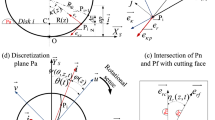Abstract
Milling of free form geometries is an usual machining operation in dies and moulds industry. A ball-end cutting tool is frequently used because its geometry allows the finishing and semi-finishing milling operations of any complex shape. However, unlike the ordinary milling machining, the tool-surface contact alternates constantly what makes the process unstable. Due to the geometrical characteristics of this process, the value of the effective tool diameter depends on the depth of cut and the surface curvature, which alters the lead angle (angle formed between tool axis and surface normal direction). The effective tool diameter alternates constantly along the machining. Moreover, it can be zero when the tool is using its centre to remove material, what makes the cutting speed null. A preview work has shown the severe alteration on the Cartesian components of the machining force when milling free form geometries. Such force oscillation is still not predictable by the up methods, and its cutting phenomenon is still not clear. The current work aims to quantify the influences of the lead angle and the engagement of the tool tip centre into the cutting region, which may lead to improvements on the choice of milling strategy in machining research and application. To do so, the machining force and its Cartesian components were investigated according to the process variables, such as: (1) tool path direction, (2) cutting way, (3) cutting speed, and (4) tool-surface contact (lead angle); when milling free form geometries with a ball-end cutting tool. Geometrical analyses together with milling experiments were carried out. The results show that the tool-surface contact had the greatest impact on the forces, because it can either be related to the effective tool diameter or with the tool tip on the cutting zone. In this area, the material is removed part by shearing and part by ploughing (plastic deformation), which increases the forces. The ascendant feed direction propitiates more stable process than its counterpart, and the cutting speed had also an influence on the forces, regardless the contact between the tools with the machined surface.












Similar content being viewed by others
References
Altan T, Lilly B, Yen YC (2001) Manufacturing of dies and molds. CIRP Ann Manuf Technol 50:404–422
Aspinwall DK, Dewes RC, Ng EG, Sage C, Soo SL (2007) The influence of cutter orientation and workpiece angle on machinability when high speed milling Inconel 718 under finishing conditions. Int J Mach Tools Manuf 47:1839–1846
Boujelbene M, Moisan A, Tounsi N, Brenier B (2004) Productivity enhancement in dies and moulds manufacturing by the use of C1 continuous tool path. Int J Mach Tools Manuf 44:101–107
Chiang ST, Tsai CM, Lee AC (1995) Analysis of cutting forces in ball-end milling. J Mater Process Technol Amst 47(3/4):231–249
Coelho RT, Souza AF, Roger AR, Rigatti AMY, Ribeiro AAL (2009) Mechanistic approach to predict real machining time for milling free form geometries applying high feed speed. Int J Adv Manuf Technol 46:1103–1111. doi:10.1007/s00170-009-2183-8
Fontaine M, Devillez A, Moufki A, Dudzinski D (2006) Predictive force model for ball-end milling and experimental validation with a wavelike form machining test. Int J Mach Tools Manuf 46:367–380
Fontaine M, Moufki A, Devillez A, Dudzinski D (2007) Modelling of cutting forces in ball-end milling with tool-surface inclination Part I: predictive force model and experimental validation. J Mater Process Technol 189:73–84
Ikua BW, Tanaka H, Obata F, Sakamoto S, Kishi T (2001) Prediction of cutting forces and machining error in ball end milling of curved surfaces-I theoretical analysis. J Int Soc Precis Eng Nanotechnol 25:266–273
Ikua BW, Tanaka H, Obata F, Sakamoto S, Kishi T, Ishii T (2002) Prediction of cutting forces and machining error in ball end milling of curved surfaces-II experimental verification. J Int Soc Precis Eng Nanotechnol 26:69–82
Kacelj B, Kopa J, Kampu Z, Kazuman K (2004) Speciality of HSC in manufacturing of forging dies. J Mater Process Technol 157–158:536–542
Kaymakci M, Lazoglu I (2008) Tool path selection strategies for complex sculptured surface machining. Mach Sci Technol 12:119–132
Krajanik P, Kopac J (2004) Modern machining of die and mold tools. J Mater Process Technol 157–158:534–552
Lazoglu I (2003) Sculptured surface machining: a generalized model of ball-end milling force system. Int J Mach Tools Manuf Amst 43(5):453–462
Liu N, Loftus M, Whitten A (2005) Surface finish visualisation in high speed, ball nose milling applications. Int J Mach Tools Manuf 45:1152–1161
Ozturk E, Tunc L, Budak E (2009) Investigation of lead and tilt angle effects in 5-axis ball-end milling process. Int J Mach Tools Manuf 49(14):1053–1062
Qingyuan C, Jun Z, Shiguo H, Xiaoxiao C (2012) Force coefficients identification considering inclination angle for ball-end finish milling. Precis Eng, Vol. 36. doi:10.1016/j.precisioneng.2011.10.007
Souza AF, Coelho RT, Rodrigues AR (2010) Manufacturing complex geometries using high speed cutting technology. VDM Verlag 1:130
Souza AF, Bodziak S (2012) Advanced free form manufacturing by computer aided systems—Cax. In: Murat Gokcek (Org.). Mechanical Engineering: Nigde University, 2011. INTECH, vol., pp 555–586. doi:10.5772/36324
Souza AF, Coelho RT (2007) Experimental investigation of feed rate limitations on high speed milling aimed at industrial applications. Int J Adv Manuf Technol 32:1104–1114
Souza AF, Diniz AE, Rodrigues AR, Coelho RT (2014) Investigating the cutting phenomena in free-form milling using a ball-end cutting tool for die and mold manufacturing. Int J Adv Manuf Technol 71:1565–1577. doi:10.1007/s00170-013-5579-4
Trent EM, Wright PK (2000) Metal cutting, 4th edn. Butterworth-Heinemann, Woburn, p 446
Acknowledgments
The authors thank CAPES for supporting this research project under the Grant PROENGENHARIAS PE 27/2008; CNPq for the postdoctoral scholarship 150174/2012-8-PDS; FAPESC under Project No. 04/2011 and the enterprises Villares Metals; VERO-SESCOI and CGTech.
Author information
Authors and Affiliations
Corresponding author
Additional information
Technical Editor: Alexandre Mendes Abrao.
Rights and permissions
About this article
Cite this article
de Souza, A.F., Berkenbrock, E., Diniz, A.E. et al. Influences of the tool path strategy on the machining force when milling free form geometries with a ball-end cutting tool. J Braz. Soc. Mech. Sci. Eng. 37, 675–687 (2015). https://doi.org/10.1007/s40430-014-0200-9
Received:
Accepted:
Published:
Issue Date:
DOI: https://doi.org/10.1007/s40430-014-0200-9




